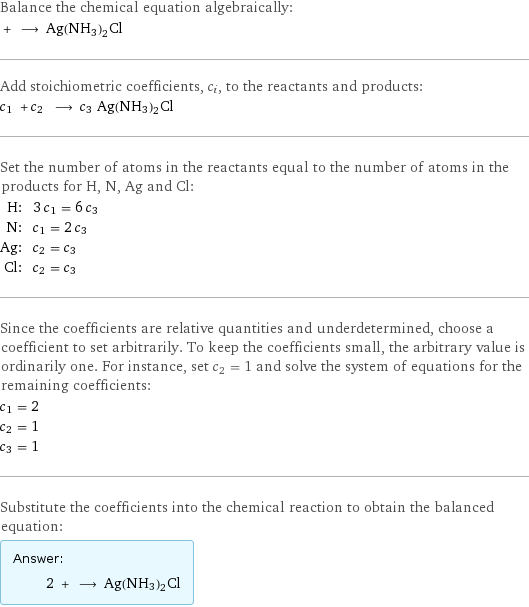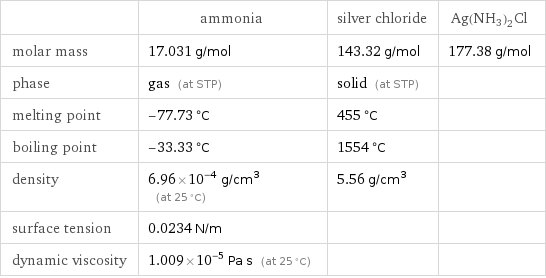Input interpretation

ammonia + silver chloride ⟶ Ag(NH3)2Cl
Balanced equation

Balance the chemical equation algebraically: + ⟶ Ag(NH3)2Cl Add stoichiometric coefficients, c_i, to the reactants and products: c_1 + c_2 ⟶ c_3 Ag(NH3)2Cl Set the number of atoms in the reactants equal to the number of atoms in the products for H, N, Ag and Cl: H: | 3 c_1 = 6 c_3 N: | c_1 = 2 c_3 Ag: | c_2 = c_3 Cl: | c_2 = c_3 Since the coefficients are relative quantities and underdetermined, choose a coefficient to set arbitrarily. To keep the coefficients small, the arbitrary value is ordinarily one. For instance, set c_2 = 1 and solve the system of equations for the remaining coefficients: c_1 = 2 c_2 = 1 c_3 = 1 Substitute the coefficients into the chemical reaction to obtain the balanced equation: Answer: | | 2 + ⟶ Ag(NH3)2Cl
Structures

+ ⟶ Ag(NH3)2Cl
Names

ammonia + silver chloride ⟶ Ag(NH3)2Cl
Chemical names and formulas

| ammonia | silver chloride | Ag(NH3)2Cl formula | | | Ag(NH3)2Cl Hill formula | H_3N | AgCl | H6AgClN2 name | ammonia | silver chloride | IUPAC name | ammonia | chlorosilver |
Substance properties

| ammonia | silver chloride | Ag(NH3)2Cl molar mass | 17.031 g/mol | 143.32 g/mol | 177.38 g/mol phase | gas (at STP) | solid (at STP) | melting point | -77.73 °C | 455 °C | boiling point | -33.33 °C | 1554 °C | density | 6.96×10^-4 g/cm^3 (at 25 °C) | 5.56 g/cm^3 | surface tension | 0.0234 N/m | | dynamic viscosity | 1.009×10^-5 Pa s (at 25 °C) | |
Units
